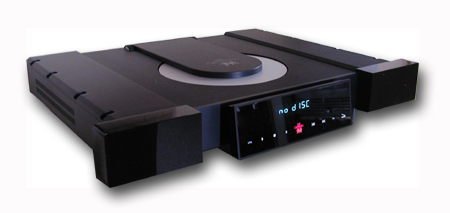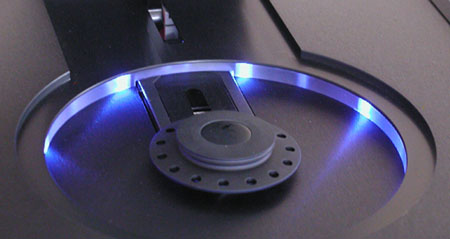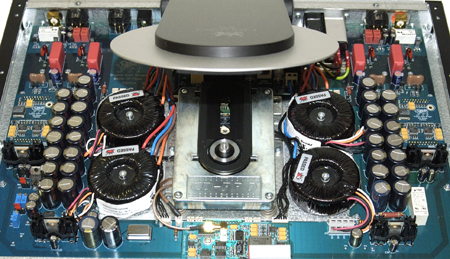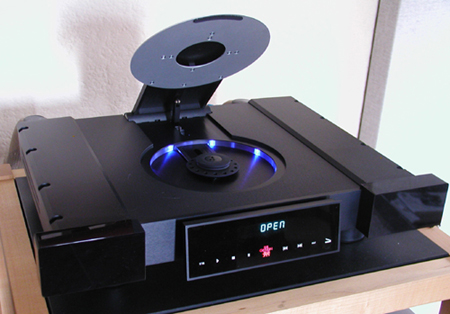You are reading the older HTML site
Positive Feedback ISSUE
13
may/june 2004
gryphon
Mikado CD player
as reviewed by Dave Clark and Robert H. Levi

Photographs and image processing by Dave Clark
DAVE CLARK'S SYSTEM: LOUDSPEAKERS ELECTRONICS SOURCES CABLES ACCESSORIES
|
 The
Gryphon Mikado is one of those once-in-a-lifetime opportunities for an audio
reviewer. Since I don’t have $12K CD players popping out of my ears, the
chance to review a source that not only pushes the price barrier but the
engineering barrier made the decision a non-issue. Sure, there are way more
expensive two-box units and a smattering of pricier one-box units, but this
is by the far the most expensive front end component I have ever had in my
system, and it looks better than many that cost more. I have had pricier
amplifiers in my system, but when Flemming Rasmussen offered PFO the
chance to be one of the first websites to review the Mikado, I didn’t have
to think twice. What do you think I am, some sort of audio miser? This is a
$12,000 Gryphon CD player! The chance to see how good my Cary 306/200
stacked up was irresistible. (They share much in common when you look at the
specs—see Bob Levi’s review below—and the price differential is not that
great if you consider that the Cary was made overseas, and would cost much
more than its $6K asking piece if it were made here.)
The
Gryphon Mikado is one of those once-in-a-lifetime opportunities for an audio
reviewer. Since I don’t have $12K CD players popping out of my ears, the
chance to review a source that not only pushes the price barrier but the
engineering barrier made the decision a non-issue. Sure, there are way more
expensive two-box units and a smattering of pricier one-box units, but this
is by the far the most expensive front end component I have ever had in my
system, and it looks better than many that cost more. I have had pricier
amplifiers in my system, but when Flemming Rasmussen offered PFO the
chance to be one of the first websites to review the Mikado, I didn’t have
to think twice. What do you think I am, some sort of audio miser? This is a
$12,000 Gryphon CD player! The chance to see how good my Cary 306/200
stacked up was irresistible. (They share much in common when you look at the
specs—see Bob Levi’s review below—and the price differential is not that
great if you consider that the Cary was made overseas, and would cost much
more than its $6K asking piece if it were made here.)
Let me start with a little history. Gryphon championed the idea of dual-mono design, one that considers an overkill power supply the most important aspect of a circuit, and that stresses neutrality, purity, and the "essence" of music—class A, zero feedback, no noise, no nothing, just what is on the disc. Pure truth, whether you want to hear it or not. Gryphon is also a company that thinks outside of the box in terms of making some of the coolest looking stuff, due to Flemming Rasmussen’s experience in graphic design and the arts, gathered long before Gryphon hit the charts. His designs are so clean and simple, yet elaborate, that they look like they were crafted by the hand of God.
Not only does the player come with white gloves to unpack it from the somewhat less than impressive box (why waste money on a fancy box that is just going to end up in the garage holding an assortment of Christmas ornaments?), it is supplied with a polishing rag and paste, a three-ring user’s manual that is designed more like a book than some photocopied, read-it-once-and-toss-it-aside piece of disposable uselessness, and a remote that any $12K CD player would be proud to take commands from. The remote has its own leather pouch and weighs a good pound! Oh, and the player has the coolest—I mean the COOLEST—top loading lid and magnetic clamp I have ever seen. The Mikado can only be rivaled by the long-gone player from Metaxas—now that was one killer machine! In a face to face competition, it would be hard to choose which has the sexier stance, but I think the Mikado wins the pageant based on the circle of blue lights that rings the CD well. These lights allow the CD to spin in a tranquil setting of aqua-blue coolness that I assume is to address the potential harm of the red laser scatter.

I was the first to the get the Mikado, and I let it spin for a good week and a half before I attempted any serious listening. Right out of the box, the unit sounded quite good, though a bit hard and stiff. Gryphon does break in their products before they leave the factory, so the purchaser can enjoy them from the get-go, but I found that the player improved after a few hundred hours, and also that it sounded better if it was left on 24/7. Perhaps this was more an issue of settling in than anything else, but we all agree that components needs to settle in before we can really appreciate what they bring to the table.
Before I could sit back and enjoy the music, there were a few quirks I had to deal with—one relating the player’s design and the other two relating to how it mated with my system. First, the undersides of some CDs would rub when spinning—not all CDs, mind you, but enough that it was a distraction. If a CD didn’t seat just right, it would hit the raised area surrounding the laser, causing a low, chuffing sound as it spun. I found no marks on either the offending CDs or the player, but this is not something one would expect in a $12,000 CD player. Since Gryphon is not cutting any corners, I can only assume that its tolerances are very, very close, meaning that it will reveal a disc that is even slightly imperfect.
Two, the player sounded best with copper-based interconnects as opposed to silver. Since, like my system, the Mikado is balanced toward the clean and neutral, I found that I needed to add a bit more color and warmth to the plot. Which is closer to the truth depends on who is dictating the story. No doubt Dennis Had finds the Cary correct with respect to what a CD player should do with the bits, while Flemming Rasmussen feels that the Mikado does the same, but as I said, it is all a balancing act. In my system and with my taste and music, the Mikado’s balance was not what I was looking for.
Switching from the Audio Magic 4D Clairvoyant interconnects to the Soundstrings allowed me to add a bit more fullness and meat to the Mikado’s bones. The Clairvoyants are not the least bit bright, but they are very open and truthful, and brought little of the "seasoning" I was missing. The Cary already has enough of this, hence it was better balanced with the Clairvoyants. In direct comparison, using the same interconnects and power cords, the Cary had more fullness and more of that tube-like warmth that I enjoy—call it coloration or deviation from the neutral if you like–than the Mikado. It’s not that I was aware of this fault of the Cary’s before the Mikado came to town, but it just goes to show you what else is out there in the big wide audio world. The thing is, I like that kind of sound, and the Mikado, when tethered to the Clairvoyants, was too lean and analytical for my taste. Switching to the Soundstrings helped it get closer to the sound of the Cary, and to what we are in tune with.
Three, the Mikado was very sensitive to my choice of power cord. Although it has a killer power supply, I found that the better the AC cord, the better the Mikado sounded. The Blue Circle BC63 was a bit too lean, and the Sahuaro had a bit too much bass bloat, but the Elrod EPS-2 made things juussst right. Forget going into an AC unit—the Gryphon seemed happier getting its juice directly from the wall. Gee, so you think this has something to do with the power supply? I can imagine Flemming objecting to the idea of changing the tonal pallet with interconnects and AC cords, as the Gryphon mantra is to keep things absolutely clean and neutral, but I like what I like and I may be too old to change. With the cables that worked for me, I was better able to appreciate what the Mikado is about. What is that, you ask?
Uh… can you say transparency, neutrality, purity, bass control, dynamics, bass slam, pitch, speed, and did I mention the bass? Man, the Cary was the champ in the bass—I mean, people would grin as the room was awash with really deep and powerful bass—but with the Mikado in house, the Cary sounded slow and fat. Too much boom, like what I see in the mirror as I approach fifty—too loose and fat, needing to exercise a bit, to tighten things up and keep from getting flabby around the middle. Admittedly, this was with the Sahuaro AC cord on the Cary, and switching to an Elrod EPS-2 brought the bass much, much closer to that of the Mikado—but geesh! The Mikado had that iron-fisted control. The bass just slammed into my chest with such an amazing degree of slam, control, and definition that it was just creepy—no, make that damn scary—how good the bass was with the Mikado. It is a true bass reference, standing head and shoulders above the rest. Playing any disc from Yello or Bill Laswell, the quality and quantity was just too fun to let it go. Out came every disc that I could find, to hear what the Cary had only suggested.
The Mikado is a transparent window to what is on the disc. You may not like what it tells you, but that’s the bits. It is honest, truthful, and without bias. Yes, it could come across as lean when compared to the Cary, but again we beg the question, which is more correct? With the Mikado, the midrange was very smooth, with nary a blemish or smudge. Instruments came across as if they were right there in the room—fast, upfront, and with that startling jump factor that often made me turn to see what had just happened. Horns took on that in-your-face edge that they can only do in a live setting, though perhaps a bit too much depending on the source. Some discs came across as just right, while others were a bit too over the top—too upfront and without enough ease and warmth. Was this more an issue of the recording quality than the character of the player? Without doubt, the Cary allowed me to listen to a greater assortment of discs with fewer complaints. Even so, I preferred the Mikado with rock and electronic music, the Cary with acoustic jazz. Rock and electronic music allowed the Mikado to show its strengths, but my acoustic selections often lost too much of the ease and naturalness that the Cary brings to the table.
Was the Gryphon too clean and neutral? For me, yes. I prefer a fuller and less laid-bare presentation. Even with carefully chosen interconnects and AC cabling, the Mikado cannot be tricked into being a rich and warm player. It is not bright or upfront. While its treble is extended and clean, with no hint of edge, grit, or glare, it is more "out there" for the listener to appreciate, for better or worse. The Mikado’s tonal evenness allows one to hear it all. Whether this is for you or not, only you can decide. I prefer a bit less "there" there, but that is just me.
I can’t imagine that a product built as well as the Mikado would offer any trouble. It worked flawlessly in the weeks I had it. I found the front panel controls easy to read and use (there are touch-sensitive areas on the display that are intuitively marked for their purpose—no conventional buttons), ditto the remote, the lid, and the CD clamp. The Mikado is interesting in all respects, and it has allowed me to measure where my reference player stands in relation to the best. I think my response to it was an issue of less is more. Less noise, more information. Less coloration, more tonal purity, with fewer details lost. If this is what you are after, and you have deep pockets, the Mikado may be the player for you. A true reference in just about everyway. Dave Clark
ROBERT H. LEVI'S SYSTEM LOUDSPEAKERS ELECTRONICS SOURCES CABLES
ACCESSORIES
|
 Gryphon
of Denmark has been quiet on these shores for some time, but they’re back!
The Mikado, their top-of-the-line CD player, is priced at $12,000. It is a
beautiful example of industrial art and sounds very fine. The question is:
Does it perform to the level of its lofty price or are we overpaying for the
services of middlemen in getting it to U.S. dealers?
Gryphon
of Denmark has been quiet on these shores for some time, but they’re back!
The Mikado, their top-of-the-line CD player, is priced at $12,000. It is a
beautiful example of industrial art and sounds very fine. The question is:
Does it perform to the level of its lofty price or are we overpaying for the
services of middlemen in getting it to U.S. dealers?
The Mikado is built around a highly modified Philips CD-Pro 2 top-loading, floating-suspension transport. It has an all-metal frame and a magnetic clamp (the CD is held between two strong magnets.) It uses four 2-channel AKM 24/96 Delta-Sigma D/A converters in dual differential topology, with full-time upsampling to 24/96. It also features separate regulated power supplies, no negative feedback, class A output circuitry, a first-order analog filter, four toroidal transformers, and a dual-mono configuration. It does not have HDCD. It has a signal/noise ratio of 106 dB (A-weighted) and is capable of software upgrades. Maximum output is 4.2 volts balanced, 2.1 volts single-ended. My listening was conducted in balanced configuration. The unit comes with a substantial metal remote control (made for the right handed person!), which worked flawlessly. It has single-ended and balanced outputs in both analog and digital. It comes with a detachable power cord, for which I substituted my Tara Decade and Soundstring. The unit is a top loader and needs lots of room when open, as the drawer lifts about five inches.

I compared the Mikado to my Theta Gen.5a/Jade, Marantz DV8400, and Sony SCD-1, all playing CDs. Kimber Select interconnects were used on all the players except the Marantz, on which I used the new, superb sounding Soundstring Alpha unshielded cable. Before I get to the sound, I should mention three things:
I always use a Bedini Clarifier on CDs before playing them, but the Mikado’s magnetic clamp made this a waste of time. Since the unit is all metal, does a very, very strong magnetic field around the playing mechanism make sense?
The small round clamp just below the CD only lifts the disc a tiny distance off the bottom of the inside shelf. Even slightly warped CDs strike the shelf when spinning, potentially damaging the information side. You won’t know if your CD is warped until you play it, and then it’s too late.
Multi-format players are the way to go, and are popping up like crazy. I know that you have spent a lot of dough on CDs, but DVDAs, HDVDs, and SACDs sound better. A $12,000 CD player is kind of like putting a Ferrari engine into a VW. You still have a VW—a weird VW, but a VW, nevertheless.
I first heard the Mikado on Von Schweikert VR-2 loudspeakers at a recent Los Angeles and Orange County Audio Society event. I thought it sounded better on its own than as a transport with an Electrocompaniet D-to-A. Others in the room disagreed with me. It’s rare to find a CD player that can beat a tricked-out D-to-A converter. The Mikado appeared to have more definition and ambience. It was NOT as good as the McCormick UDP-1 using SACD media, though it was superior on regular CDs. This was a promising start, so I took it home to evaluate.
The Mikado produces a very musical midrange, in a truly non-fatiguing and supremely glareless way, and is better in this respect than any CD player I have ever heard. Distortion seems lowered by a magnitude. Grain and etch are completely gone. You can listen to any CD you own, at any volume, and you’ll hear nary a trace of digititis. The player is very relaxed and analog-like, with an endless signal-to-noise ratio as a bonus. It’s very hard to live without this luxurious smoothness once you have sampled it.
The not-so-good news is that the Mikado lacks definition compared to two of my other references. The Theta combo and the Sony SCD-1 had more definition, a bigger soundstage, and a wider dynamic range than the Mikado. The Marantz DV-8400 sounded similarly smooth and delicate, but more polite, smaller in scale, and less defined. In Sonata for Violin and Piano (Wilson Audiophile 8722), the piano sounded fuller and more realistic on the Theta, while the violin was more realistic on the Mikado. Though it was wonderful with delicate and textured sounds, the Mikado’s somewhat polite nature limited its ability to recreate the bold and the powerful piano.
More not-so-good news is that the upsampling of the Mikado had unpredictable results. In Jussi Bjoerling’s The Atlanta Recital (Bluebell ABCD 020) from 1959—the only stereo recital of the great tenor ever recorded—the Theta focused the tenor more clearly, gathered the ambience more precisely, and recreated the unmiked piano more musically than the Mikado. It was as if the slightly distant perspective confused the non-defeatable upsampling in the Mikado, creating less than perfect results. The Sony also focused this disc more convincingly. Bjoerling’s delivery had more power with the Theta, a silkier sound on the Mikado. It was a tossup. In Lauridsen’s Lux Aeterna (RCM 19705), the results were the opposite—ambience made more sense with the Mikado. In fact, I’ve never heard this CD sound better. The choral sound was beyond criticism. The Theta and Sony made this delicate recording sound like Turandot by comparison.
Back to good news: With the CD layer of Blues in Orbit (MFSL UDCD 757), the Mikado let me revel in the analog-like smoothness and harmonic richness of the instruments. It was flatter and more digital sounding on the Theta, though the horns had more slam and the bass more punch. The Mikado’s missing dynamics just seemed unimportant, and a more than reasonable tradeoff for its gorgeous, digital-free sound The Sony was close to the Mikado when I used its fourth digital filter setting, but not all the way there. When I switched to the SACD layer on the Sony, however, all bets were off. Definition was better than the Mikado’s by at least 50%. Listening to Janos Starker playing Dvorak’s Cello Concerto (Mercury CD 432-001-2) was a luxurious experience with the Mikado. This is a close-up, 35mm-film recording, and it is not very warm sounding. The Mikado made it sing. The cello was darn near perfect, the violins almost sweet and way less etched. It was a bit hard sounding and glary on the Theta combo, very good to excellent on the Sony, but superb on the Mikado. The sense of the hall was a bit better on the Mikado, but only a bit. The hall sound of the Theta, with its endless dynamics, was quite exciting.
The CD layer of Super Bass 2 (Telarc 63483) just did not sound right through the Mikado. Too little drive and not enough deep bass ruined this performance for me. The Mikado put me in the room and gave realistic applause, but had very little of the necessary drive needed for three closely-miked bass fiddles. The Theta was clearly better and the Sony, when switched to the SACD layer, was alive.
The Gryphon Mikado is a midrange wonder. Its natural textures and control were a joy to hear, as was its lack of digital nasties. Its perspective is a bit distant, its dynamics and bass are not up to the level of its mids, it’s not the most detailed player, nor is it a soundstage champ, and it does not bridge the gap between SACD and CD (no player does), but it gets mighty close to analog in the important mids, making average CDs listenable and great CDs things of beauty. The question is: Is it worth $12,000, and can you live with it happily ever after? Maybe, if you have the dough, a ton of CDs, and you love music. Robert H. Levi

Mikado CD player
Retail: $12000
Gryphon
web address: www.gryphon-audio.dk
